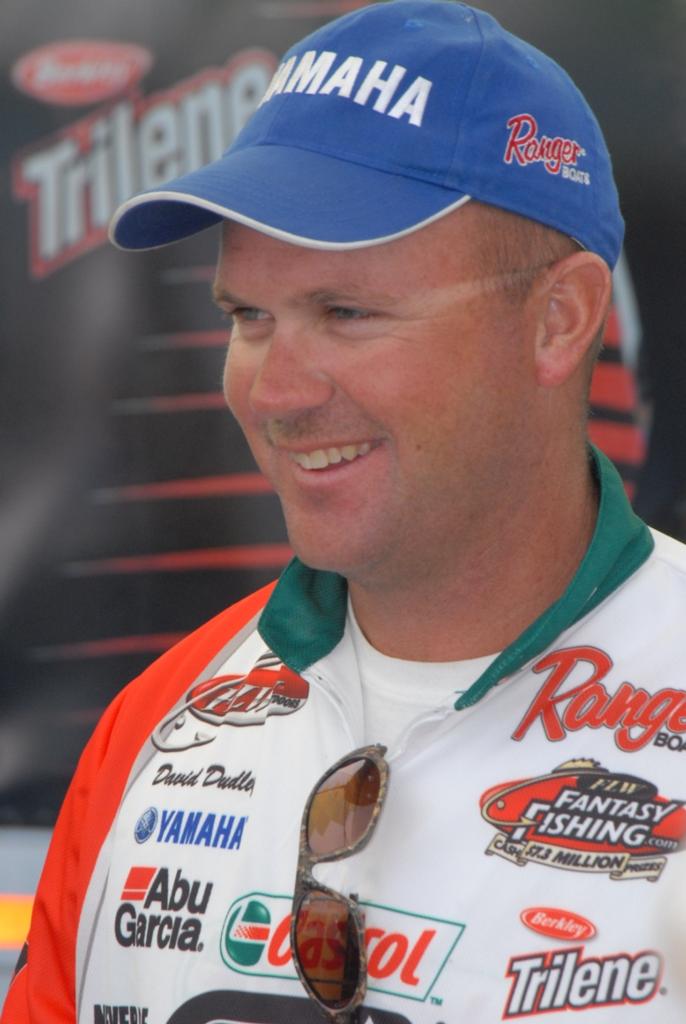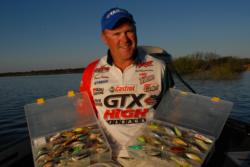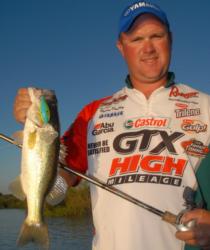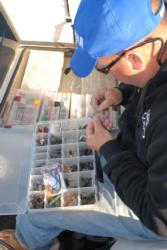Dudley the closer: Part 2
2008 FLW Tour Angler of the Year David Dudley talks offshore fishing, explains why he had to finally organize his tackle

Dudley the closer is an in-depth look at David Dudley and his uncanny ability to win big tournament titles. In Part 1, the Castrol pro spent time talking about the importance of instincts and intuition in the top levels of tournament fishing.
In Part 2, FLWOutdoors.com takes a more specific look at how Dudley applies and hones his intuitive ability on the water.
——————————————
For the first part of his career, Dudley prided himself on being a “junk fisherman,” meaning his favorite fishing technique was to run down a lake and fish anything that grabbed his intuitive attention.
“Junk-fishing is one of the best ways to hone pure instincts,” Dudley explained. “I love riding down a lake in a tournament and waiting for that gut feeling that says, `Pull over and fish that.’ It might be a lay-down, a dock, a point of vegetation, a current break, a piece of riprap – whatever. To me, that’s one of the purest forms of instinctual fishing, having no real direction or plan – just a deck full of rods and endless opportunities to cast at anything, catching a fish here and a fish there.”
But over the years, Dudley has discovered a big problem with his junk-fishing plan: It kept him bound to the bank – the same banks where 199 other boats had been fishing over the course of four days of practice.
In more recent years, Dudley started looking for ways to break his bank-fishing rut and discovered a new frontier for his intuitive impulses on offshore structure.
“Junk-fishing on the bank is great, but nothing challenges your instincts like fishing offshore on stuff you can’t visibly see,” Dudley added. “With everything underwater, it’s like a whole new hidden dimension out there – hunting fish offshore is addictive.”
In addition, he also believes that offshore is where the greatest potential to win tournaments exists. He quickly points to the success of other fishing icons, such as David Fritts and Rick Clunn, who figured this out long ago.
And he’s proved this theory to himself with his last two FLW wins on the Tour and in the Series.
“After spending 20 years in this sport, I’m now convinced that on any given lake, the majority of bass live offshore, especially the better-quality bass,” Dudley offered. “Sure, they come to the bank to spawn in the spring, but then I think they go right back out offshore, spending very little time up around the bank.”
Dudley says it’s anyone’s guess as to why bass behave this way. Perhaps it’s fishing pressure, perhaps new species of baitfish inundating our waterways (such as blue-black herring) are leading bass to live more nomadic lives, or maybe bass are just smarter these days.
When cornered for an answer on this topic, Dudley reverts to his simple logic.
“For the most part, a bass is born in shallow water; that much we know, right?” he reasoned. “It lives in shallow water for the first part of its life. And while it’s up there cruising the bank as a 10- to 14-incher, it gets caught a couple of times. If the fish is lucky, it gets released. But after a while, that fish starts to realize that when it is out off the bank, it gets hassled a lot less than when it ventures up to the bank. When a bass reaches that 3-pound mark, it’s capable of making a living offshore where it’s safer.”
Dudley’s change in perspective came from several key tournaments over the past few years, starting with FLW events at Kentucky Lake in 2004 and 2006, where fish were caught “offshore” despite the water being flooded in the bushes.
“In those events, everybody said the fish were in the bushes, but those tournaments were won offshore,” Dudley pointed out. “Also, there was a BASS event on Grand Lake last year that Kevin VanDam won – same thing – the water came up, and Kevin caught them cranking points offshore.
“And look at the FLW on Beaver Lake this year,” he continued. “The water was way high, and where were the leaders fishing? That’s right. Out off the bank.”
Dudley, however, says it’s important not to confuse the term “offshore” with the word “deep.”
“Offshore does not always mean deep,” he cautioned. “Some of the best offshore spots that sit way out in the middle of a lake can be 4 to 6 feet deep.”
Since he has moved his search offshore, Dudley’s No. 1 fishing tool has become a crankbait. The Castrol pro now carries boxes and boxes of crankbaits that range from shallow square-bills to ultradeep-divers.
When beginning his search in practice, Dudley is very unconcerned about color, style or wobble of a crankbait; he just wants to cover water.
“I am purposely looking for fish that will bite anything that moves – those are the ones that are grouped up and in competition with each other,” Dudley explained. “Those are the ones that win tournaments – like the ones I found at Fort Loudoun this year.”
Reading a fish’s level of aggressiveness is a key component to Dudley’s new offshore game plan; it’s something he learned as kid while fishing trout streams in North Carolina.
“Just about everything I’ve learned about bass fishing, I learned from catching trout in streams,” Dudley said. “And one of the biggest lessons streams taught me was how to read a fish’s aggressiveness, based on how that fish is positioned in the stream.”
Essentially, Dudley noticed that large concentrations of trout in the deeper holes at the base of chutes were always the easiest to catch while the singles or doubles of trout cruising down the stream’s banks were the hardest to fool.
“When you see just one, two or three trout by themselves, those jokers are almost impossible to catch,” Dudley explained. “You have to make just the right cast at just the right drift and do all that `match the hatch’ stuff. I mean, if your salmon egg is not the right color, they won’t touch it.
“But, if you see a school of about 20 or 30 trout at the base of chute or in a deeper hole – you can run a little spinner through there at any angle, and one is going to come after it because those fish are in competition.
“It’s all about competition, and bass are no different,” he continued. “The more competition there is, the more aggressive the fish are going to be. And these days I spend more time looking for those gangs of fish `at the bottom of the chute’ rather than trying to finesse the ones on the bank with everyone else.”
The offshore plan does not always work, and sometimes Dudley ends up on the bank junk-fishing anyway. But when it works, as it did at Fort Loudoun, it’s a runaway victory.
This fall, two other FLW Outdoors events were dominated in the very fashion Dudley describes. First, David Fritts walloped the field at the FLW Series Eastern Division event on Clarks Hill by fishing offshore with a crankbait. And then David Curtis of Texas ran away with the Stren Series Championship on Table Rock by tapping an offshore location with crankbaits, Carolina rigs and jigs.
“Those are two perfect examples of what I’m talking about,” Dudley said. “Those are needle-in-a-haystack kind of places, but when you find that needle along a 10-mile ledge, it’s the mother lode.”
One of the most interesting things Dudley has discovered about these kinds of offshore schools of bass is there is very little rhyme or reason as to where they position along a break.
“I’m still learning about this kind of fishing, and I’m by no means an expert, but I can tell you this: Finding these kinds of schools is not about idling around with your depth finder, looking for cover; it’s about fishing ledges for hours and hours until you happen upon the school while fishing.
 “The few times I have found these kinds of schools, they had two major things in common. One, I found them while I was covering water with a crankbait; I did not graph a bunch of `arches’ on a picture-perfect ledge loaded with cover, throw out there and start catching them. And two, when I went back with a depth finder to see what was down there, there was absolutely nothing – the places were completely slick and bare. And that’s what’s so puzzling: The bottom looked no different than the other 10 miles of ledge around it.”
“The few times I have found these kinds of schools, they had two major things in common. One, I found them while I was covering water with a crankbait; I did not graph a bunch of `arches’ on a picture-perfect ledge loaded with cover, throw out there and start catching them. And two, when I went back with a depth finder to see what was down there, there was absolutely nothing – the places were completely slick and bare. And that’s what’s so puzzling: The bottom looked no different than the other 10 miles of ledge around it.”
The other thing Dudley has struggled with in his offshore approach is getting the fish to stay in one place. At Fort Loudoun-Tellico, his fish stayed put. But other times, they have vanished.
“One that still burns me up is the Forrest Wood Cup on Lake Ouachita,” he lamented. “I don’t want to dwell on it, because I can’t stand listening to people who always win practice. But all I’ll say is that I found the mother lode on a river ledge during practice.
“I cranked ledges for two days of practice without a bite, and when I finally found them, it was unreal. I mean, every cast was a fish. And it was one of those places like I’m talking about: just a slick river ledge with nothing on it. The first day of the tournament I caught a limit in five casts. The second day, same thing. When I found the right cast, I caught a limit in no time. The third day it took a little longer – maybe 30 or 40 casts. But on the last day, they didn’t pull any water, and those fish dissappeared on me, and I finished eighth.”
If Dudley’s new way of fishing sounds like it’s a form of chasing ghosts, those ghosts better keep finding good places to hide, because he’s on an intuitive mission to find them.
“I’m telling you, I love it,” Dudley quipped. “Feeling my way down those ledges with a crankbait, looking for that glory school of bass is so gratifying to my instincts. It sounds like some kind of over-the-rainbow, pot-of-gold myth, but once it happens to you – like it happened to me at Fort Loudoun – it’s hard to go back and beat the bank.”
Another interesting thing Dudley points out about locating schools is after catching a few on crankbait, the school gets “busted up,” and the competition among the fish begins to wane.
“That’s when you have to go to more the dragging-type baits like a football jig, Carolina rig or Texas rig,” he revealed. “You can find a wad of fish on a crankbait, but once you remove fish from that spot, less fish means less competition, and the fish get pickier about what they eat. At Fort Loudoun, I used a crankbait the first two days, but then had to `drag’ my way to the win on the last two days with a Texas-rigged Power Worm and jig.”
And if you are hoping to learn what Dudley’s favorite crankbait is for this job, forget it. He literally carries hundreds of crankbaits of every make, model, size and color, and he uses all of them.
The brands of crankbaits he relies on runs the gamut from Toshinari Namiki’s O.S.P. and Tennessee-style homemade crankbaits for the shallow end to Norman, Strike King and Luhr Jensen on the deep end.
Recently, this writer spent a day of practice with Dudley during the FLW Series East-West Fish-Off, and I can attest that he goes through crankbaits the way NASCAR teams go through wrenches.
But one thing that did shock me was that all of his crankbaits were in great shape and very well organized – a sharp departure from the Dudley I had come to know over the years.
The last time I had spent time in his boat, his one crankbait box was half-full of water, and his crankbaits were the same two colors: rusty red and corrosion crust.
Much to my surprise, Dudley has turned over a new leaf, or perhaps a new tree, in tackle organization. And not just crankbaits either. Hooks, weights, jigs, soft plastics, spinnerbaits – they all had a safe, dry and easy-to-find home in his boat.
“Yeah, I had to swallow my pride on tackle organization,” Dudley confessed with a laugh. “All those years I talked smack, saying that tackle maintenance doesn’t matter – well, it does, big time.
“Now let me just say that I still do not stay up all hours of the night putting 10 strands of orange in my jig skirts and coloring my plastic trailers like some kind of art project, but I do spend a lot more time caring for and organizing baits than I used to.”
Dudley said the need to organize grew out of his strong desire to follow his intuitive impulses (described in Part 1) more fluidly during the day.
 “Like I said, it’s a bad thing when you box in, or close off, your instincts,” he explained. “And I noticed that too many times I was boxing off those gut feelings about certain lures because I did not have them or could not find them in my boat. If my gut said, `Go with a 6- to 8-foot runner in a chartreuse and blue,’ and I did not have it, that’s as detrimental to your intuition as getting to a fishing spot and finding someone already on it.
“Like I said, it’s a bad thing when you box in, or close off, your instincts,” he explained. “And I noticed that too many times I was boxing off those gut feelings about certain lures because I did not have them or could not find them in my boat. If my gut said, `Go with a 6- to 8-foot runner in a chartreuse and blue,’ and I did not have it, that’s as detrimental to your intuition as getting to a fishing spot and finding someone already on it.
“The biggest difference, though, is I can control having lures available for my gut feelings. And that’s how it happened. Now I can put my hands on anything in a matter of seconds. Being able to do that this year was a big key in staying near the top in the points and winning the Angler of the Year.”
With his win at Loudoun-Tellico and a 2008 Angler of the Year trophy to boot, Dudley has averaged one major win per year for the last six years. Those are some impressive stats, given the sheer number of great anglers he faces in competition day in and day out.
And considering that he has discovered a new offshore frontier on which to foster his fishing instincts, it’s a pretty sure bet that his winning ways will continue.